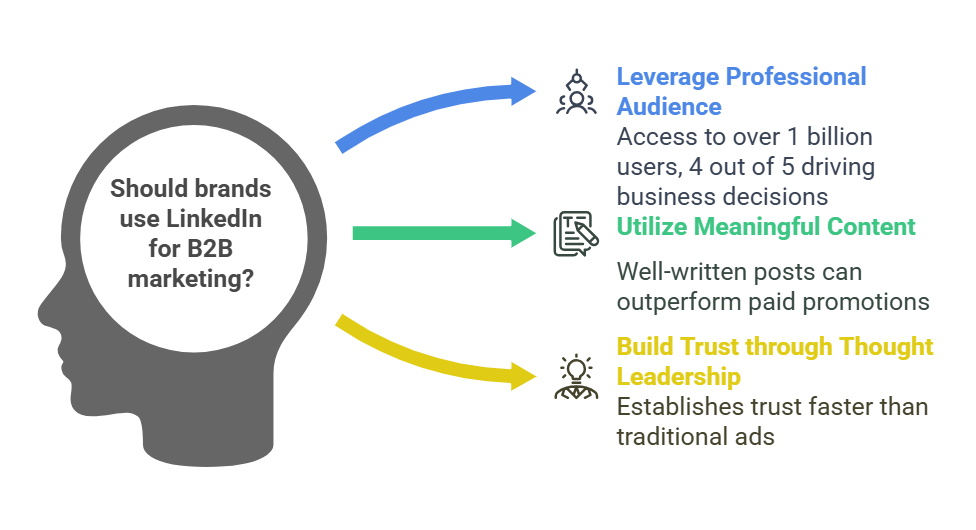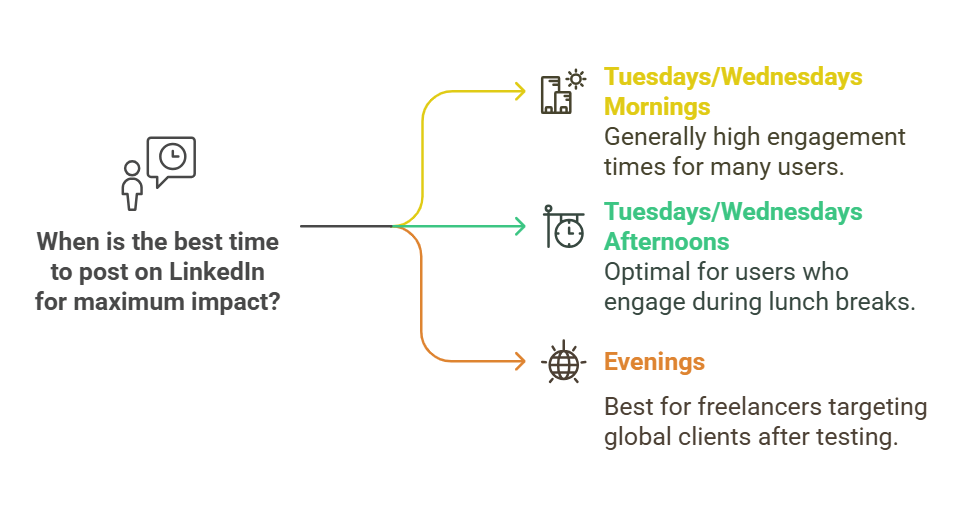Struggling to get noticed on LinkedIn?
Wondering why your posts aren’t getting traction?
You’re not alone.
Let’s cut through the noise and talk real strategies.
How should you use LinkedIn to promote your brand?
Start with your profile.
If it looks like a resume from 2010, you’re losing opportunities.
Use a clear headshot, a headline that screams what you do, and a summary that tells your story.
Check out LinkedIn’s guide on profile optimization for specifics.
Post regularly, but don’t spam.
Aim for 3-5 times a week.
Share insights, ask questions, or drop quick tips.
Consistency builds familiarity.
One entrepreneur I know doubled her connections in 90 days just by posting every Monday and Thursday.
Engage like you’re at a networking event.
Comment on posts in your industry.
Reply to every comment on your content.
It’s not about shouting into the void—it’s about starting conversations.
Why should brands use LinkedIn?
It’s where professionals hang out.
Over 1 billion users, and 4 out of 5 of them drive business decisions.
If you’re selling B2B, ignoring LinkedIn is like skipping Thanksgiving dinner—you miss the main event.
The platform’s algorithm favors meaningful content over flashy ads.
A well-written post about a client success story can outperform a paid promotion.
Forbes highlights how thought leadership here builds trust faster than traditional ads.

How often should you post on LinkedIn for personal branding?
Quality beats quantity, but consistency matters.
Posting 15-20 times a month keeps you visible without burning out.
Space it out—3 times a week works for most.
Test different schedules.
One marketing exec posts short tips daily, while a CEO shares deep dives once a week.
Both get results.
Use a content calendar to stay organized.
Why post on LinkedIn?
It’s a reputation machine.
Every post is a chance to showcase expertise.
A consultant I follow landed a $50k project because a post went viral in his niche.
Networking here is low-pressure.
A comment on someone’s post can lead to a DM, then a Zoom call.
It’s like a 24/7 conference where everyone has a name tag.
What are the best days and times to post on LinkedIn for maximum impact?
Tuesdays and Wednesdays at 8-10 AM or 12-2 PM (local time) tend to work.
But your audience might be different.
A freelancer targeting global clients found evenings best after testing for a month.
Use LinkedIn Analytics to track your top-performing posts.
Adjust based on when your network is active.

The content types that work in any industry
Mix these formats to keep your feed fresh:
| Content Type | Best For | Engagement Level |
|---|---|---|
| Text Posts | Quick tips, hot takes | Medium |
| Videos | Tutorials, stories | High |
| Polls | Audience opinions | Medium |
| Documents | Deep dives, guides | High |
| Stories | Day-in-the-life | High |
Videos under 90 seconds get shared 3x more than text-only posts.
Polls spark conversations—ask, “What’s your biggest challenge this quarter?”
Where to find content ideas that actually work
Steal from your own life.
Did a client ask a question? Turn the answer into a post.
Stuck in a meeting that could’ve been an email? Rant about productivity hacks.
Follow industry leaders and repurpose their ideas with your spin.
Join LinkedIn Groups to see what your peers are debating.
Use AnswerThePublic to find questions people are asking about your field.
How to generate posts that get likes, shares, and DMs
Start with a hook.
“95% of startups fail—here’s how to avoid it” beats “Tips for startups.”
Use numbers, questions, or bold statements.
Keep paragraphs short.
One sentence.
One idea.
Like this.
Add a call to action.
End with, “What would you add?” or “Tag someone who needs this.”
Final thoughts
LinkedIn isn’t a magic bullet.
It’s a grind, but the payoff is real.
Post consistently, engage authentically, and tweak based on what works.
Your turn.
Drop a comment with your top LinkedIn tip—let’s learn from each other.
Share this post if it helped, and let’s get your brand the attention it deserves.
Need more ideas? Check out Hootsuite’s list of LinkedIn post templates.
Or dive into Sprout Social’s data on viral content.
Sources:
1. LinkedIn Marketing Solutions Blog
- Why It’s Useful: This is LinkedIn’s official blog, offering the most up-to-date and authoritative advice on content strategies, trends, and best practices.
- How to Use It: Reference it for insights on LinkedIn’s algorithm, post formats, and engagement tips.
2. Sprout Social: LinkedIn Content Marketing
- Why It’s Useful: A comprehensive guide to LinkedIn content marketing, including post ideas, strategies, and analytics.
- How to Use It: Use it to support your points on creating engaging content and measuring success.
3. Hootsuite: What to Post on LinkedIn
- Why It’s Useful: Practical advice on creating LinkedIn posts, with examples and templates.
- How to Use It: Reference it for specific post ideas and formats that work well on LinkedIn.
4. Forbes: Building Your Personal Brand on LinkedIn
- Why It’s Useful: Expert advice on leveraging LinkedIn for personal branding, with actionable steps.
- How to Use It: Use it to highlight the importance of authenticity and storytelling in personal branding.
5. HubSpot: Best Times to Post on LinkedIn
- Why It’s Useful: Research-backed insights on the best days and times to post for maximum visibility.
- How to Use It: Reference it when discussing timing and frequency for LinkedIn posts.





There is definately a lot to find out about this subject. I like all the points you made
Very well presented. Every quote was awesome and thanks for sharing the content. Keep sharing and keep motivating others.
**mind vault**
mind vault is a premium cognitive support formula created for adults 45+. It’s thoughtfully designed to help maintain clear thinking
**breathe**
breathe is a plant-powered tincture crafted to promote lung performance and enhance your breathing quality.